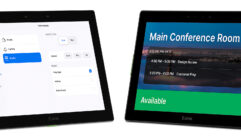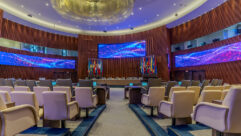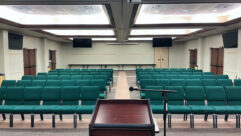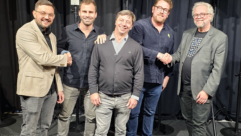
On this edition of the SVC Podcast, Contributing Editor Bennett Liles wraps up his conversation with Joey Loeffler, VP at San Antonio Sound & Light (SASL) and Garydavid Royce, Senior AV Design Engineer at Uber Advanced Technologies Group (ATG) about a fifty conference room AV project at Uber’s Pittsburgh office. In addition to the Biamp Systems SCR-20 Devio conferencing hubs and TCM-1 Beamtracking Microphones, Huddly Go cameras, Extron cable cubbies, Aver wide angle PTZ cameras and QSC ceiling speakers were used in the installation known internally as the “Crucible Project”.

Links of Interest:
· Uber Advanced Technologies Group (ATG)
· Biamp TCM-1 Beamtracking microphones
This is the SVC Podcast from Sound & Video Contractor with Joey Loeffler of San Antonio Sound & Light and Garydavid Royce of Uber ATG. We’ve got the show notes and product links for all of the podcasts at svconline.com. Go to Podcasts at the top of the page.
When Biamp’s Devio conferencing systems were introduced to Uber’s conference rooms they brought in usability and professional appearance. Uber’s Garydavid Royce and Joey Loeffler of San Antonio Sound & Light (SASL) are back this week with the tech details on how they’re bringing this massive project along. That’s coming right up on the SVC Podcast.
Joey Loeffler and Garydavid Royce, great to have you both back with us from SASL in San Antonio and Uber in Pittsburgh. We’re talking about the Crucible Project at the Pittsburgh Uber office outfitting a lot of different types of conference rooms and training areas with Biamp conferencing gear. That gives them a successful and consistent user experience. We talked about audio last week but Garydavid, I wanted to ask you first and then Joey. What was the most consistent video problem that you encountered in this wide range of room types?
Garydavid: I think the largest video problem is to make sure that we’re thinking about the far side, especially when it comes to the video conferencing. And that usually comes down to making sure that the video cameras, the lenses, are at the appropriate height to make it more of a natural feel. A lot of times we – in the industry we fall short and we mount cameras above the displays and more or less provide that God view. Or a lot of times we mount the cameras too low and it’s capturing an individual’s stomach or chest area rather than their face or their eyes. So we made sure that within all the rooms the camera lenses were mounted at 48 inches above finished floor and the average individual’s eye height. So on the far side it provided that more natural feel. And then when people are looking at the displays within the room, they weren’t even noticing it or realizing it, but they were actually looking at the camera lens as well. So it still provided that more natural experience as if the far side participants were in the room themselves.
Joey: I think Garydavid had a great design when he put together these rooms. All of them are dual-display rooms and utilizing a small wide-angle camera from Huddly – and the majority of the rooms at Crucible are smaller huddle-type spaces, so we put the small, wide-angle Huddly camera right in between the displays and it looks incredibly clean. The camera is nearly invisible with the darker acoustic treatments that are on the wall. And so when participants are in that room looking at the space, you know, looking at the far end viewers on the TVs, they’re on the same eye level as everyone else. So it’s such a natural experience. And like Garydavid was saying, so many rooms you go into, architects or the users of that room, they want that camera out of sight – away. And it provides such a poor experience for the far end. That was a main focal point here. It was a little bit of a challenge getting it work out right and look clean in the rooms, but I feel like we succeeded well.
Garydavid: What also was a big win, and a challenge with the video, is knowing that all the technology was more or less going to be mounted on the display wall or the north wall in a sense. But we wanted to keep that consistent theme of that invisible comfort, so we wanted to more or less camouflage, in a sense, the technology. And that was a challenge because a lot of times cameras come in a silver or a white color and not necessarily a dark gray or black color. So we reached out to various manufacturers to find out if that was even an option and believe it nor not it was. So we were able to have a display wall that was covered in darkish acoustical treatment and then the displays were a dark color, the camera was black – so that was kind of hidden out of sight – and then the cabinetry was black. So again, if the user walks into a room the main focal point wasn’t the technology and they’re not really noticing that there’s a camera even in the room so they’re not being distracted when they’re making conversations to the far side or point-to-point. [Timestamp: 4:11]
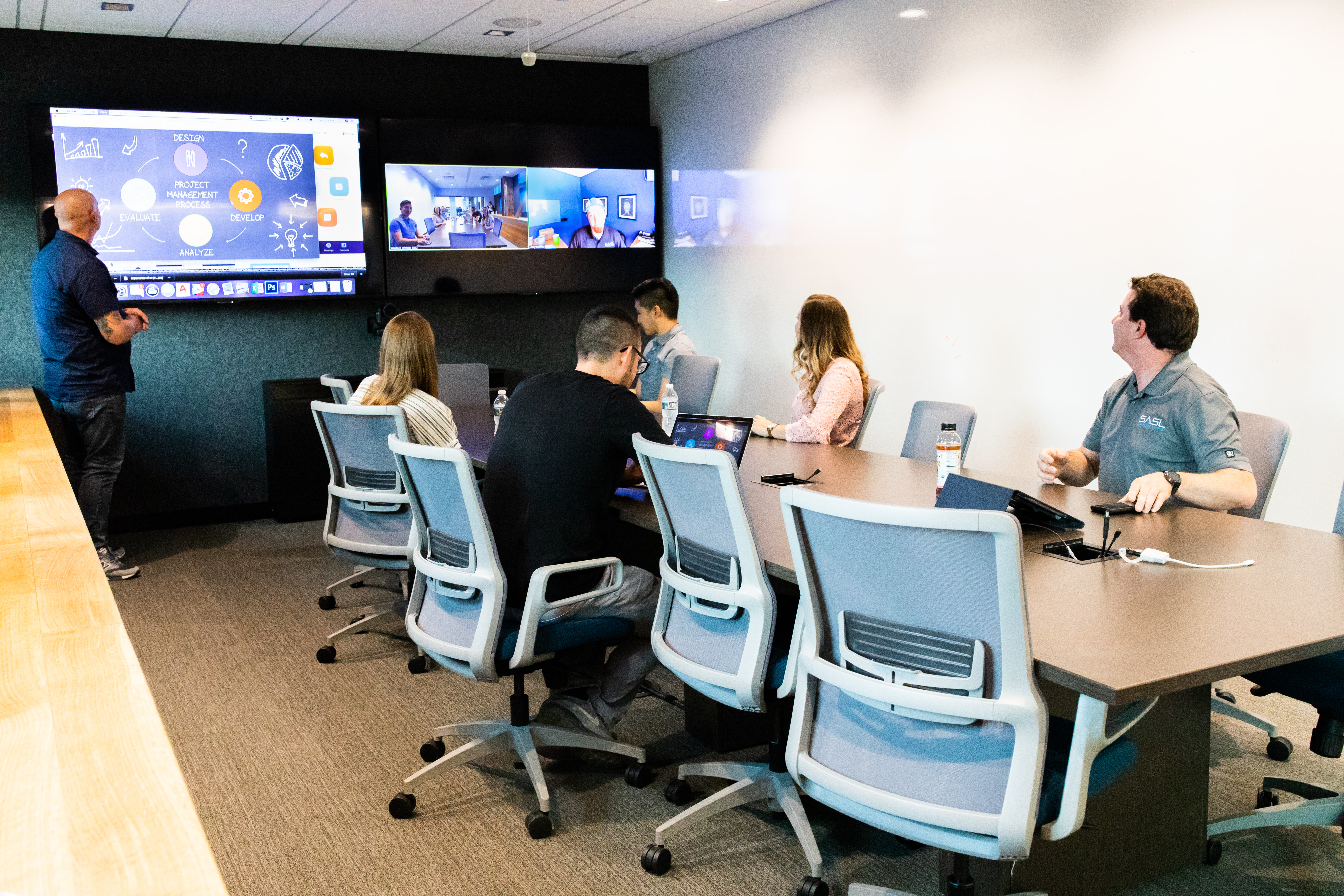
And when they walk in and see everything pretty well matched up instead of a lot of different colors and finishes it looks like there was more of a grand plan for the whole thing and not just a bunch of add-ons.
Garydavid: That was some positive feedback from users. It provided confidence to users because the users understood that we had a plan going into this.
And one of the more subjective things on this is the sound. How did you address mic pickup, feedback, echo control, sound level management and those sorts of things?
Joey: I think that magic was really a lot in the Biamp Devio solution. We did make a good amount of effort to make sure the microphones were placed properly. We did some testing just to make sure that we had the appropriate pickup in all the rooms. We laid it all out on the RCP plans for the project so our installers and everyone knew exactly where they were going to go, and then it was easy for the installers to make sure it was the same in every room. With good quality speakers from QSC properly placed, with properly placed microphones, Devio’s auto calibration just worked really, really well and gave us amazing quality. And then the larger rooms using Tesira, we were able to program it to work as well if not maybe a little better than even some of the Devio rooms. [Timestamp: 5:24]
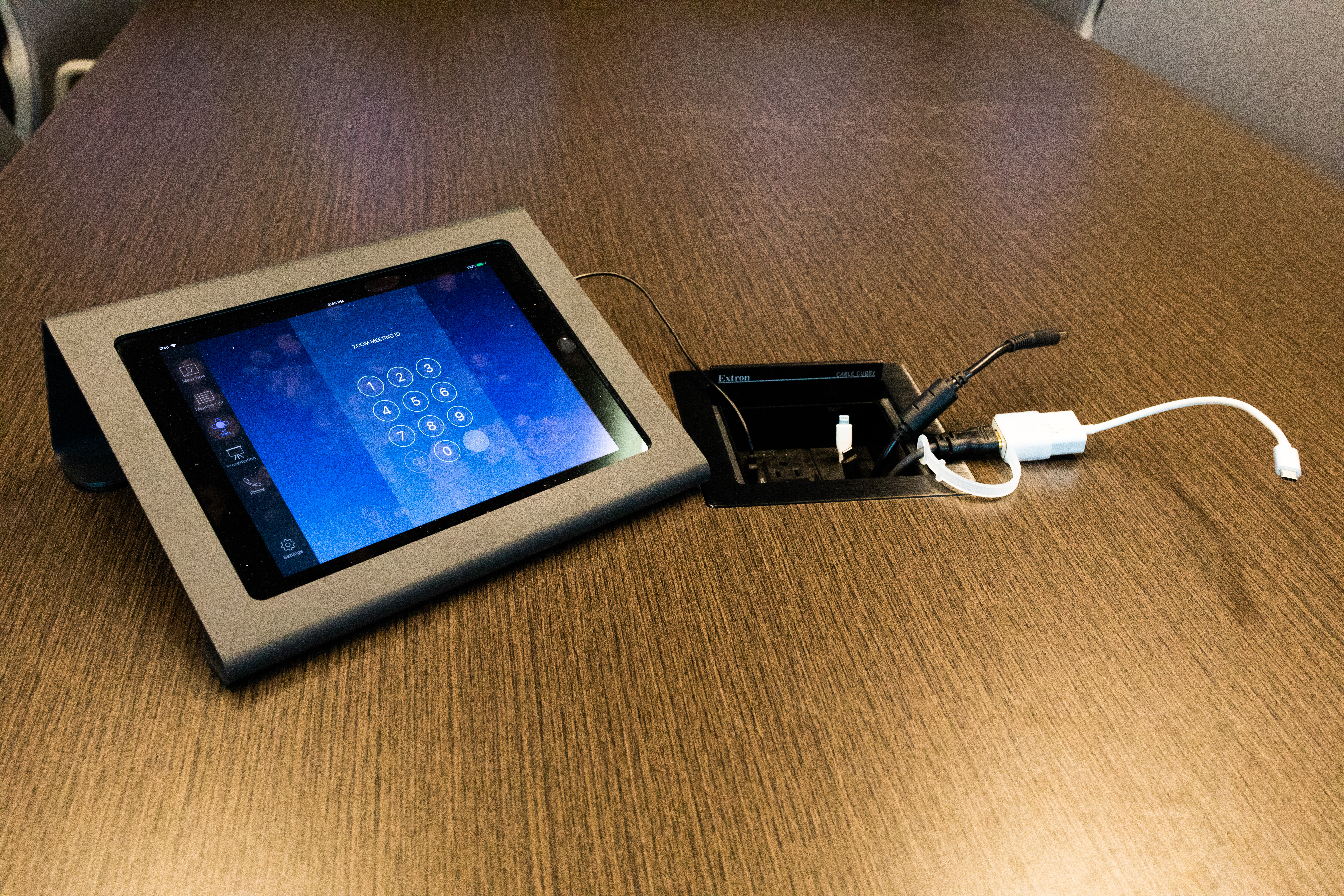
There is such a wide range of room sizes on this project I would think that the room acoustics would be pretty widely varied and that would be something special to deal with as well.
Garydavid: We worked very closely with the facilities team on making sure acoustical treatment was added to all the room types. And then we just led with the basic principles on if there’s two parallel hard surface walls just making sure that one of those walls is acoustically treated. So the theme of the consistent feel within a small to and extra-large room was kept not only within the technology, but the space planning as well. So the display wall and then a parallel wall to the display wall was always covered with acoustical treatment and then the other wall was covered with this white board material. So it was the same experience for any user to walk into a room. They always knew the white wall they could start marking on and collaborating and then the other walls were allowing that acoustical treatment but it provided some texture. It wasn’t just the four walls were white. So it wasn’t your typical conference rooms. It was adding principals to help with the acoustics, but then it also changed up the environment to make it a little bit more different than your typical conference room by adding that acoustical treatment.
Joey: I think it was important for us to continue to work with the architects and make sure we were speaking up with the architecture team to make sure that we didn’t have too many hard surfaces. Some of these rooms, they would initially plan to have sheetrock ceilings in and Gary and I both kind of spoke up and said we’d really prefer to have just an acoustic ceiling tile in all these rooms to really make sure we didn’t have too many reflective surfaces. Like Gary mentioned, the acoustic treatments that were installed working with the space planning team, and then just making sure we had acoustic ceiling tiles in all of the rooms definitely improved audio quality and made it to where it could be serviced later if anyone needed to get up into the ceiling. [Timestamp: 7:21]
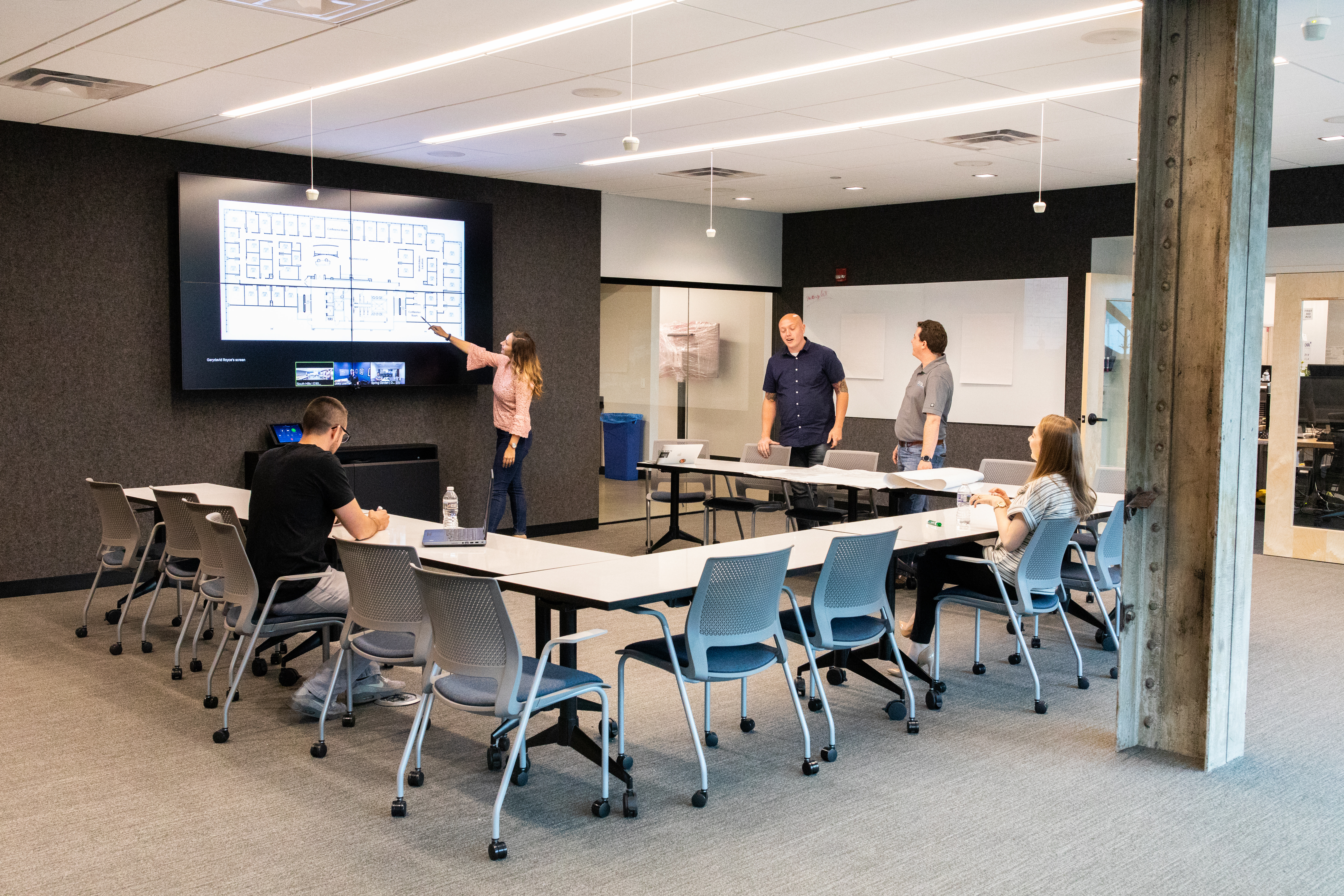
I think you used the Biamp Devio SCR-20 systems on these, is that right?
Joey: Yes, sir. That’s correct.
Garydavid: That’s correct.
Garydavid, were there special reasons or features that seemed to make those units workable for all of these different spaces?
Garydavid: Coming from the end user side, I didn’t really want to be handcuffed into learning, or not really knowing the software. And I think Biamp did an excellent job on releasing this Devio solution that I would say is a little bit more geared towards power users. Where it allows someone like myself to go in, to calibrate, to make some fine adjustments on the microphone, on the line level out, and see it in real time and still feel like I’m making a contribution or I’m able to configure the room in real time rather than having to always bring back and integrator. And then they made it more or less dummy-proof in a sense, where now the cabling is just over CAT5. And we have some calculators online to actually show you how many microphones are necessarily needed within a room and if it will work within the environment. And then they have two solutions of tabletop microphone or ceiling microphone. So I think they just did an excellent job on fulfilling the needs and the requirements for the end user, especially coming from the soft codec world. And to me it was just a big win and a big check box. They’re able to provide the same quality that you would get from a Biamp DSP we’re all used to and fit it into this all-in-one solution or a box solution that’s more geared for soft codecs and end users. That’s how they succeeded. [Timestamp: 8:55]

This was obviously a big scale and formidable project so when you get it all ready to go, the proof is when you bring people in there and turn the users loose on it. What was their reaction to these new room setups? Did you have to do any changes or tweaks after they used it or how did it go?
Garydavid: It was just smiles from ear to ear. People were very pleased and happy, but then they hit the ground running. They just started using these rooms full force and it was just very fluid. So to me we all did a job well done. There was no hiccups, there was no issues. People understood how to use the systems and then they started fully using them. Right, like a lot of times when we design a solution, the solution may not necessarily fit the needs or the requirements from the customer so they’re not using it all the time. But these rooms get booked out and the rooms are jam packed full of people and they’re truly collaborating; writing on the white board, having the camera preset, angling toward the white board so the far side can actually participate. And people are taking notes, people are standing up next to the displays pointing at their content to share and present. I mean, it’s really neat to see this transformation and seeing people communicate, and we had a part of that based off of all the hard work that we put into making sure the appropriate gear was spec’d out, configured properly, and to the appropriate locations. [Timestamp: 10:15]
Makes a huge difference in the confidence they’ll have in those rooms from now on and how much real use they’ll get. So Joey, are there projects ahead for SASL where you may be applying the experience you got on this one?
Joey: Absolutely, Bennett. We’re always learning from past projects that we complete and not only applying our experience working with some of the AV technology but also the processes to streamline our installation process. During this project, because of the distance from our home office it was important for us to make sure that we had the processes in place to install on a quick timeline and just be incredibly efficient to give the best price to our customer. As we all know, the margins on equipment are getting tighter and tighter every year so we’ll just continue to build relationships with clients like Uber and deliver quality work as efficiently as possible. [Timestamp: 11:04]
Alright, well it’s been great talking to you about this ongoing project and I wish you success with the completion of it. We’ve been talking with Joey Loeffler Vice President with SASL in San Antonio and Senior AV Design Engineer Garydavid Royce with Uber in Pittsburgh. A huge Biamp based conferencing project. Many thanks guys for getting with us.
Joey: Thank you, Bennett. We appreciate the opportunity.
Uber ATG’s new conference and training spaces are easy to use and they’re a showcase for the company. Thanks to Garydavid Royce at Uber and Joey Loeffler at SASL for giving us the story on how they got essential input from the users and took the concept to reality with Biamp Systems. Get back with us next week for another AV project on the SVC Podcast.


